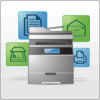Lexmark Apps Remote Copy - Page 13
Exporting and importing a configuration using MarkVision Professional, Importing a configuration
 |
View all Lexmark Apps manuals
Add to My Manuals
Save this manual to your list of manuals |
Page 13 highlights
4 Click Configure > Export. 5 Follow the instructions on the computer screen to save the configuration file, and then enter a unique file name or use the default name. Note: If a JVM Out of Memory error occurs, then repeat the export until the configuration file is saved. Importing a configuration 1 From the Embedded Web Server, click Settings or Configuration. 2 Click Device Solutions > Solutions (eSF), or click Embedded Solutions. 3 From Installed Solutions, click the name of the application you want to configure. 4 Click Configure > Import. 5 Browse to the saved configuration file, and then load or preview it. Note: If a timeout occurs and a blank screen appears, then refresh the browser, and then click Apply. Exporting and importing a configuration using MarkVision Professional Exporting configuration settings 1 From the MarkVision Professional Home screen, select Embedded Solutions - Solutions Management from the All Tasks list. 2 Using the Quick Find or Folders tabs, select the device(s) where the application is installed. Use Ctrl + click and Shift + click to select multiple devices. Note: Password-protected network devices are displayed in red. Enter the device password to gain access to the device. 3 From the list, select the name of the application you want to configure, and then click Export. 4 Browse to find a location to save the universal configuration file (.ucf), and then click Save. Importing configuration settings 1 From the MarkVision Professional Home screen, select Embedded Solutions - Solutions Management from the All Tasks list. 2 Using the Quick Find or Folders tabs, select the device(s) where the application is installed. Use Ctrl + click and Shift + click to select multiple devices. Note: Password-protected network devices are displayed in red. Enter the device password to gain access to the device. 3 From the list, select the name of the application you want to configure, and then click Import. 4 Browse to find the universal configuration file (.ucf), and then click Add. Configuring the application 13















